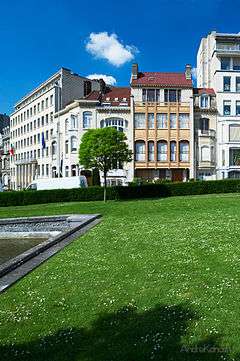Hôtel van Eetvelde
| Hotel van Eetvelde | |
|---|---|
|
Hôtel van Eetvelde (French) Hotel van Eetvelde (Dutch) | |
 | |
| General information | |
| Architectural style | Art Nouveau |
| Location | Brussels, Belgium |
| Coordinates | 50°50′49.94″N 4°22′50.11″E / 50.8472056°N 4.3805861°ECoordinates: 50°50′49.94″N 4°22′50.11″E / 50.8472056°N 4.3805861°E |
| Construction started | 1898 |
| Completed | 1900 |
| Client | Edmond van Eetvelde |
| Owner | Synergrid |
| Design and construction | |
| Architect | Victor Horta |
| Official name | Major Town Houses of the Architect Victor Horta (Brussels) |
| Type | Cultural |
| Criteria | i, ii, iv |
| Designated | 2000 (24th session) |
| Reference no. | 1005 |
| State Party |
|
| Region | Europe and North America |
The Hôtel van Eetvelde is a town house designed in 1895 by Victor Horta for Edmond van Eetvelde, administrator of Congo Free State. Together with the Hôtel Tassel, the Hôtel Solvay and his own House and atelier it was put on the 'UNESCO World Heritage List' in 2000 as the core of epoch-making urban residences Victor Horta designed before 1900. It is located at 4 Avenue Palmerston in Brussels.
Building
The visible application of "industrial" materials such as steel and glass was a novel for prestigious private dwellings at the time. In the Hôtel van Eetvelde Horta also used a hanging steel construction for the façade. The interior receives additional lighting through a central reception room covered by a stained-glass cupola. An extension to the house was designed by Horta in 1898. This building has a more conventional, beautifully detailed sandstone façade. It was designed to house a garage, an office for van Eetvelde as well as supporting apartments and therefore had a separate entrance (2 Avenue Palmerston).
| “ | The Hotel van Eetvelde in Brussels was designed in 1898[sic] by Victor Horta, undoubtedly the key European Art Nouveau architect. While most other architects flirted with the new style, Horta found it gave the best expression to his ideas. His skill is demonstrated in his ability to slip his domestic designs into narrow constricted sites. The interiors become of great importance as centres of light, which permeates through the filigree domes and skylights—usually in the centre of the building. The Hotel van Eetvelde is a remarkable example of the way Horta handled the situation and used it to highlight the imposing staircase, which leads up to the first-floor reception rooms.[1] | ” |
Awards
The UNESCO commission recognized the Hôtel van Eetvelde as UNESCO World Heritage in 2000.
| “ | The four major town houses - Hôtel Tassel, Hôtel Solvay, Hôtel van Eetvelde, and Maison & Atelier Horta - located in Brussels and designed by the architect Victor Horta, one of the earliest initiators of Art Nouveau, are some of the most remarkable pioneering works of architecture of the end of the 19th century. The stylistic revolution represented by these works is characterised by their open plan, the diffusion of light, and the brilliant joining of the curved lines of decoration with the structure of the building. | ” |
See also
Notes
References
- Aubry, Françoise; Vandenbreeden, Jos (1996). Horta — Art Nouveau to Modernism. Ghent: Ludion Press. ISBN 0-8109-6333-7.
- Campbell, Gordon (2006). The Grove Encyclopedia of Decorative Arts. Oxford: Oxford University Press. p. 490. ISBN 0-19-518948-5.
- Sembach, Klaus-Jurgen (2002). Art Nouveau. Köln: Taschen. p. 47. ISBN 3-8228-2022-9.
- Cuito, Aurora (2003). Victor Horta. City: Te Neues Publishing Company. ISBN 3-8238-5542-5.
External links
 Media related to Hotel van Eetvelde at Wikimedia Commons
Media related to Hotel van Eetvelde at Wikimedia Commons- Hôtel van Eetvelde on greatbuildings.com
